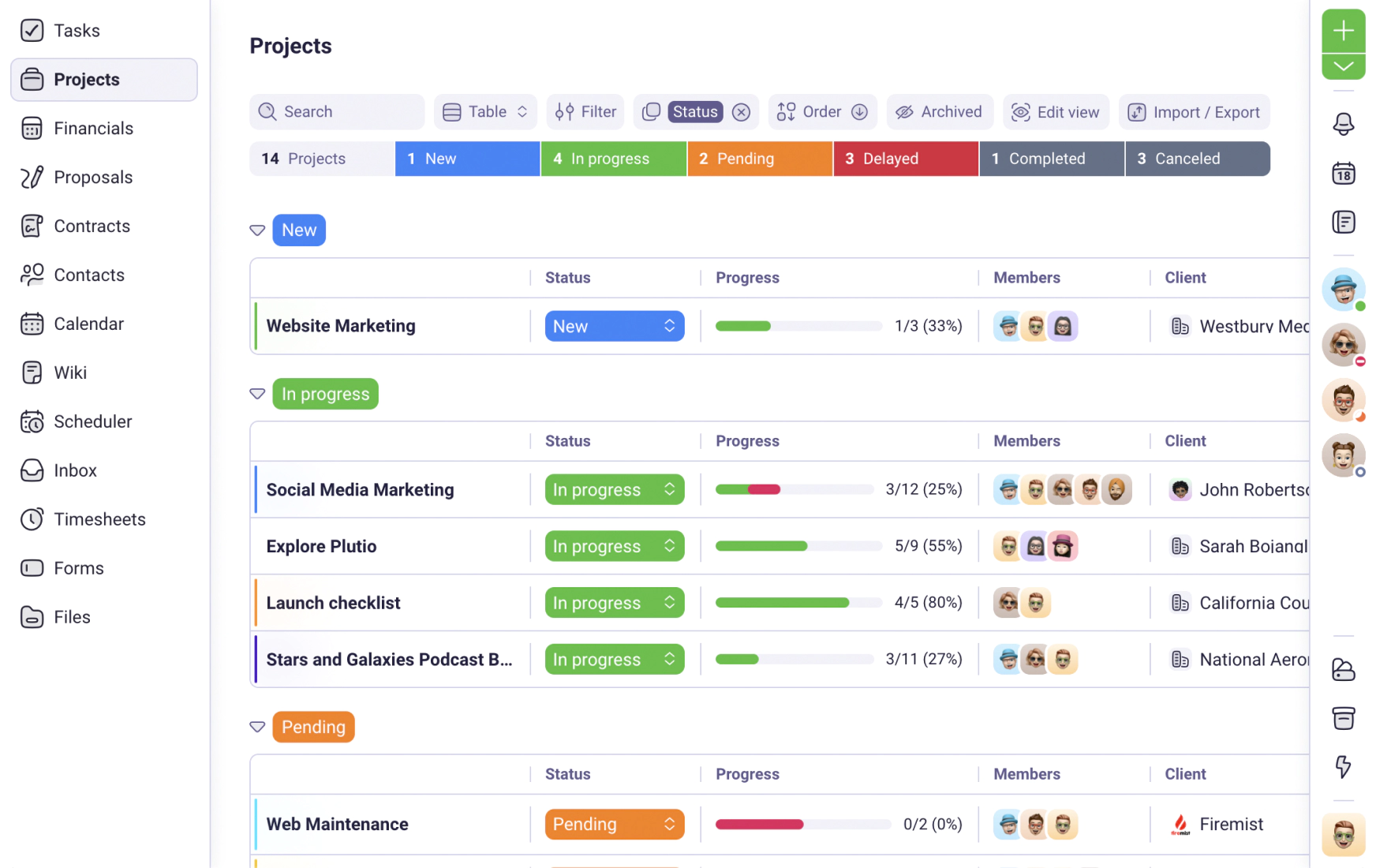We use cookies to personalise and enhance your experience.
Going freelance has been a popular career choice for many workers for a few years now, but 2020 saw unprecedented levels of individual workers moving to home offices. In fact, half of employed Americans worked remotely with freelancers contributing $1.2 trillion to the U.S. economy that year. But, while working as a freelancer has a number of advantages -- such as more freedom -- it also presents a number of challenges.
Workflow management is one of the biggest challenges faced by freelancers. When you work in an office, workflow is taken care of by your manager. As a freelancer, it’s now up to you to manage your tasks for improved efficiency.
But while it’s certainly challenging, getting to grips with managing your workflow means everything else fits together. You’ll be more organized, it will be easier to stay on top of projects, manage your cash flow, and your clients will ultimately be impressed and satisfied.
In this article, we’ll be taking a look at 7 workflow management tips for freelancers that will help you restructure for success.
1. Strategically Name Your Files and Folders
One of the things that can slow down any worker is unnamed files and folders. When you need something but can’t find it (because you haven’t correctly named the file), it can set you back, causing frustration and even delaying a project. Worse still, you might never find what you’re looking for.
This is why it’s important to always name your files and folders (your future self will be grateful). It’s simple enough to do, too. Just create a new folder each time you start a new project, before adding subfolders for each task and subtasks. For example, graphic designers can create separate subfolders for logos, business cards, and so on.
Then, simply name each file based on their criteria/content. For instance, if you’ve created 5 different logos for a coffee house, you could name one file “coffee_house_logo_1” and another file “coffee_house_logo_2.”
2. Create a Schedule (and Stick to it)
Without a schedule, it’s easy to feel lost as a freelancer. You don’t know for sure what you should be working on and at what time, which can lead to chaos. Worse still, it can mean tasks that should have been prioritized are left stranded at the back of the queue, which leaves you playing catch-up.
Staying on top of things and ensuring deadlines are never missed is one of the key reasons we create schedules as freelancers. And while they suit visually-minded people in particular, all types of freelancers should use them as they create the foundation for your week ahead.
To create a weekly and daily schedule, you should first outline exactly what needs to be done in the week ahead. Then, you can decide how many hours and how often you’ll be working.
Next, set your exact working hours, setting aside time for lunch and any other types of breaks, such as work meetings/calls and looking for new clients. This must all enter your schedule if you’re to maximize your time and not fall into the trap of working more hours than you planned.
Then, prioritize your tasks according to their urgency and importance. Decide on how to fit them into your schedule according to how urgent and/or important they are. If something needs to be completed by the upcoming Wednesday, it’s always better to fit it into your schedule sooner rather than later. Projects and tasks that don’t need to be completed just yet can be added later.
Lastly, it’s always helpful to use a tool to help you visualize your schedule and mark everything down. Such a tool comes with helpful notifications that allow you to stay on top of things.
3. Declutter Your Workspace
As we know, efficiency is key to better workflow management. And the key to efficiency is organization.
An organized workspace is a decluttered workspace. When you declutter your workspace, you’ll feel more relaxed and at ease, and this will allow you to work better. You’ll no longer need to keep clearing your desk and you won’t struggle to find important documents that you need.
Here are some tips:
- Identify your necessities: What important items do you always need to hand? Identify what these are and place them within hand’s reach. Anything extraneous that really isn’t needed should be placed elsewhere.
- Create zones around your desk/workspace: For example, you could compartmentalize your desk according to zones for research, zones for drafts, meetings and so on.
- Don’t eat lunch at your desk: Eating lunch at your desk just increases the risk that you will leave unnecessary items, such as plates and wrappers, in places where they will just sit and cause more stress further down the line.
4. Refine Intelligent Processes for Each Task
The best way to boost your daily efficiency and productivity is to find ways to get better at each task so that you perform them faster without sacrificing quality. And the easiest way to get better and faster at each task is to develop intelligent processes.
When you’re performing repetitive tasks each day, it’s important that you understand what’s working and what isn’t. What speeds up your tasks and what slows them down? Do you easily get distracted? In which case, iron out those distractions.
Then, begin by timing yourself at each task. Learn how long it takes to complete your tasks, and then look for ways you can improve that time. Put yourself in competition with yourself. The trick is to improve your time while maintaining high standards.
Look for new ways you can improve your processes, always. What tools will prove invaluable? Will outsourcing certain tasks help?
5. Invest in Improving Your Communication
If there’s one thing that can threaten to derail your workflow, it’s poor client communication. When you don’t communicate properly with clients, misunderstandings can occur, conflict might even arise - and a project slows down.
It’s therefore essential that you find ways to communicate effectively and consistently with your clients.
- Use tools: There are lots of communication tools to choose from, but the modern-day freelancer should also look at creating chatbots that allow them to answer basic questions with their clients whenever they’re busy. This will allow you to stay in touch during hectic times before you can engage with the client properly 1:1.
- Use different mediums: As well as utilizing bots and other tools, make sure to be accessible to your clients across a wide variety of mediums, including email and Skype/Zoom.
- Ask questions: If you’re not sure about something, it’s better to ask the client to clarify as soon as possible. This will help to prevent delays from occurring later on.
- Set expectations: Clients need to know what to expect from a working relationship, and so do you. Make sure you understand expectations when it comes to things like updates and when and where they can expect to converse with you.
6. Learn to Market Yourself Effectively
To get business, you must be able to market yourself to stand out amongst your competitors. And you need to have a system in place that speeds up your marketing efforts so that you acquire and manage leads effectively.
First you must pinpoint the right marketing strategies that work best for your freelancing business and dig into them. We recommend trying out the following:
i. Promote Yourself Offline
Don’t limit your marketing activities to online, as there are still many opportunities available to freelancers in the offline world. They are:
a. Direct Mail
A powerful way to grow your freelance business is through direct mail. Make sure you do your research on which area to target, as it can be quite expensive. Through your direct mail campaign, let the reader know how it will benefit them if they get in touch.
b. Networking
See what’s on in your city or town within the upcoming months that’s relevant to your business. Attend the event and make sure you connect with the people there with the intention to build relationships.
c. Business Cards
Using business cards spreads the visibility of your freelance business. Having them handy to give to a manager or acquaintance, for example, is a great way to exchange information in face-to-face meetings. You can go a step further and use a QR Code Generator to create a QR code for your business cards and set it up to open on your website. This makes it super easy for leads to follow up with you on your website.
d. Build a Social Media Audience
Social media boosts brand awareness and visibility, making it easy to cultivate a new audience and attract leads. Your social media profiles should include your name and a short bio of what services you provide. It’s also important to keep your personal and professional accounts separate.
Consistently promote the content that you create. I recommend doing this by creating a branded link and sharing it in your posts. This type of link may convert higher as it will indicate where it leads after users click on it.
e. Build and Display Your Portfolio
Building and displaying a portfolio is crucial to attracting freelance clients. Ideally, your portfolio will be located on your freelance website. It will introduce who you are and help build a connection with potential clients. It will also save you time filtering out clients that are not a suitable fit for your business, as your unique style may not suit them.
Top tip: To avoid the dreaded feast or famine that many freelancers experience, it’s a good idea to build multiple income streams that can be worked on in between projects. A few examples are building rank and rent websites, writing ebooks, creating online courses, or designing WordPress themes and plugins.
Wrapping Up
The better you can manage your workflow, the more rewarding your career as will be. Use the tips in this article to stay on top of clients, tasks, and projects, and ultimately lead a successful life as a freelancer in today’s uncertain economy.
About the author: Ashley Kimler is the founder of CopyNoise. She's been working remotely in the tech space since 2014. Interested in getting her advice on your blog? She's always looking for the opportunity to share her perspective with new communities! Follow @ashleykimler on Twitter to see what's new.
Have you tried Plutio yet?
The only app you need to run your business and get work done.
Try Plutio for FREESupercharge your business
The complete toolkit to run your business
The intuitive all-in-one solution to manage and collaborate on projects, share files, build forms, create proposals, get paid, and automate your workflow.
No credit card required


